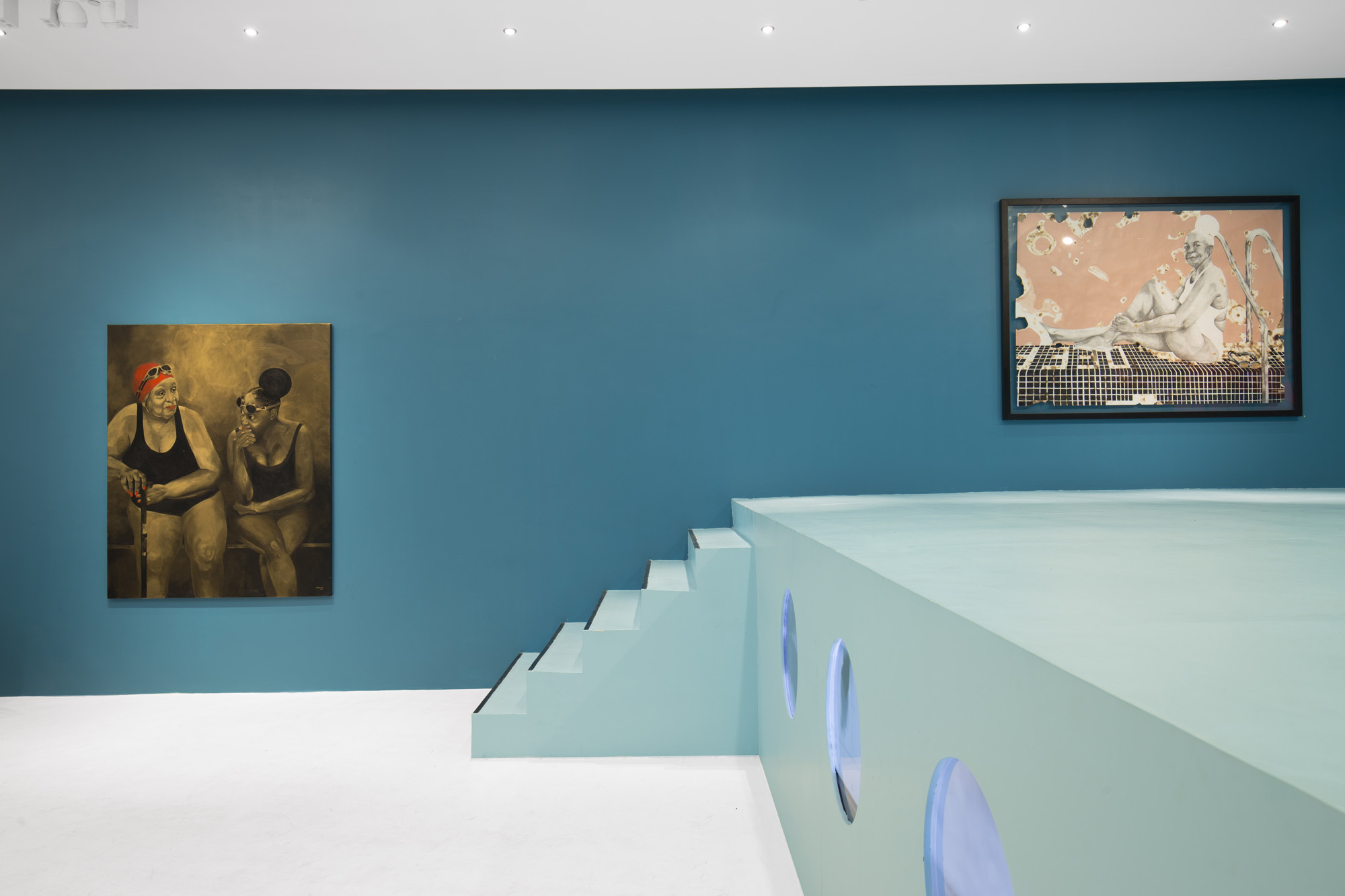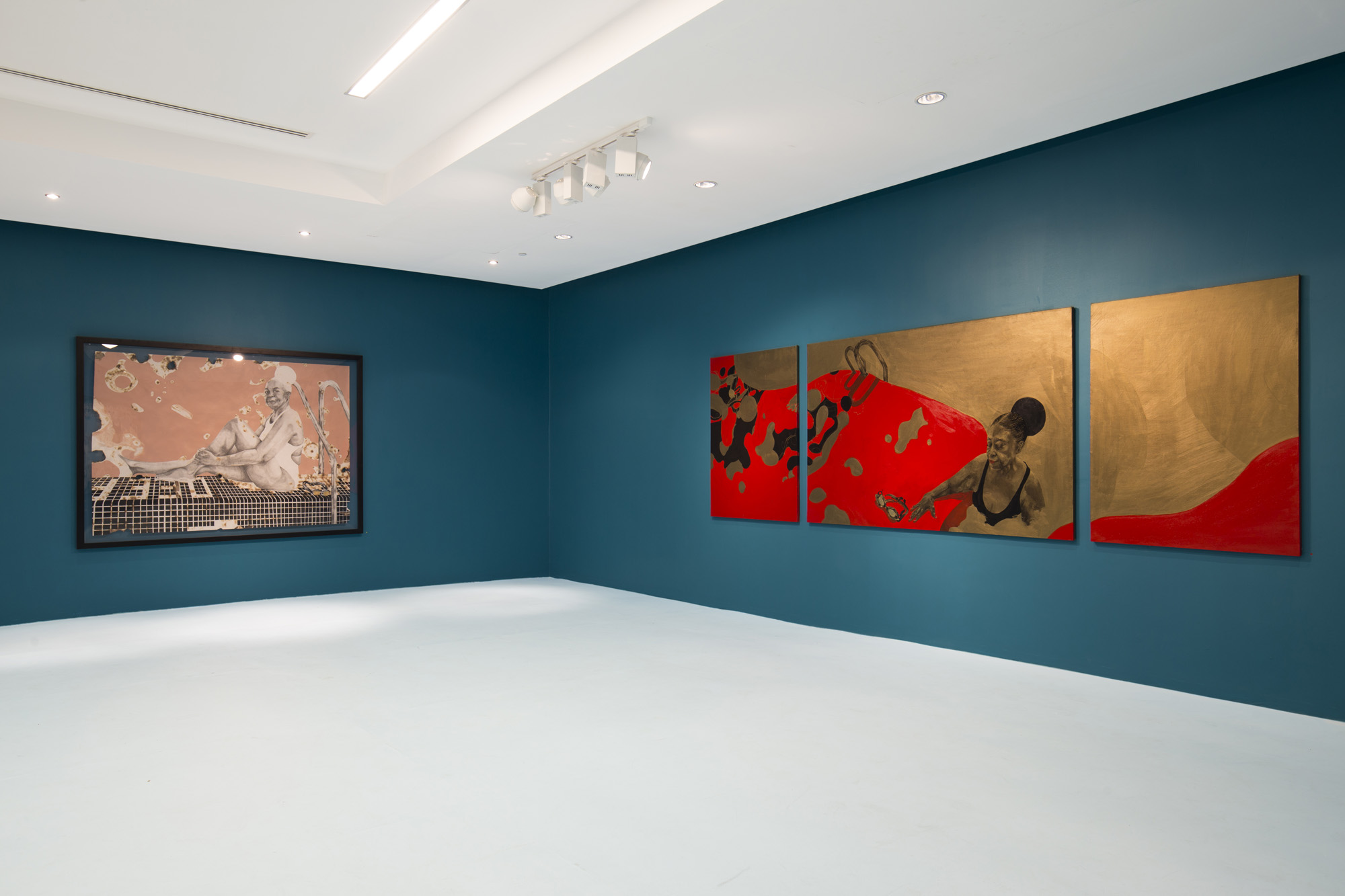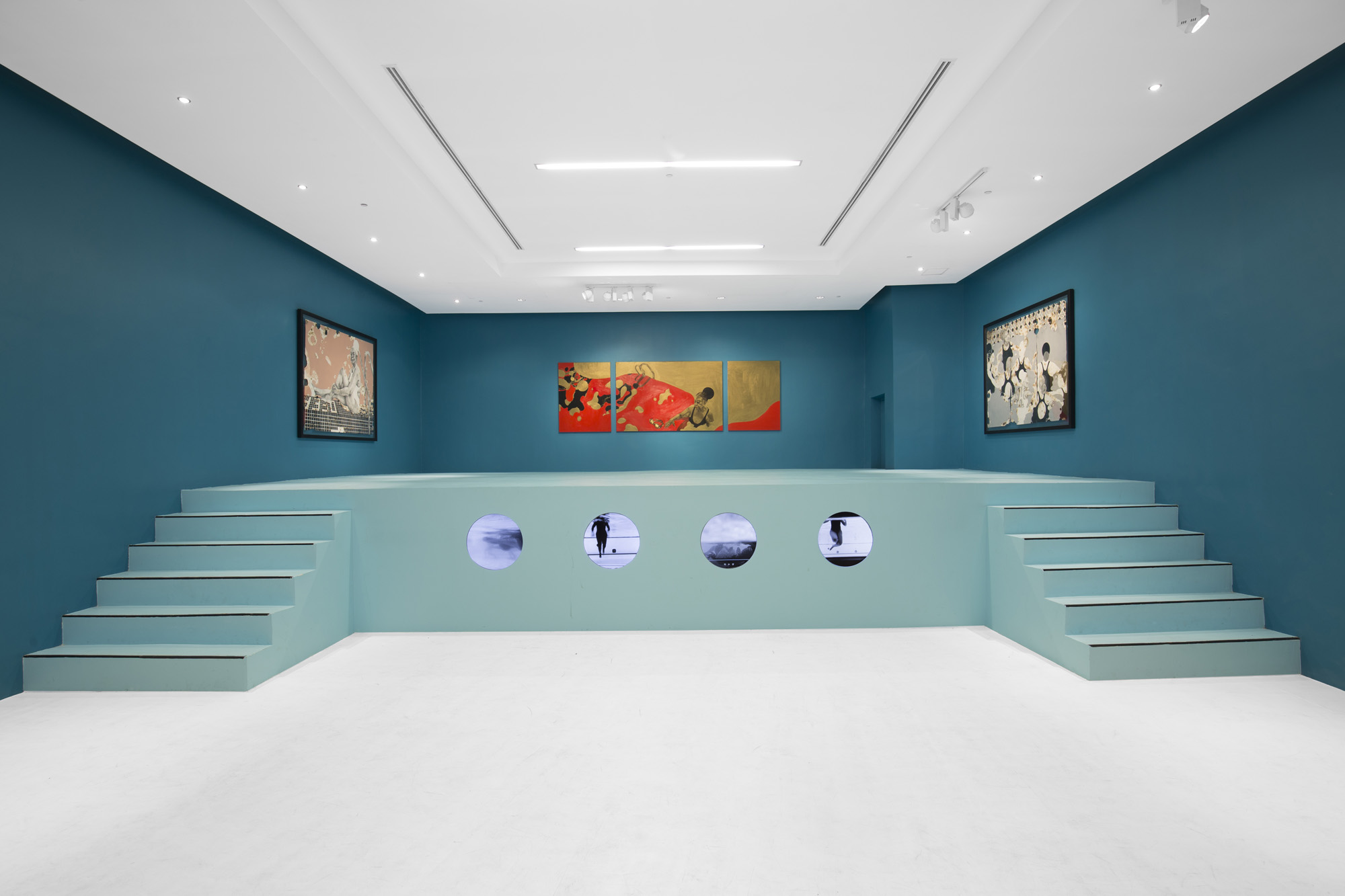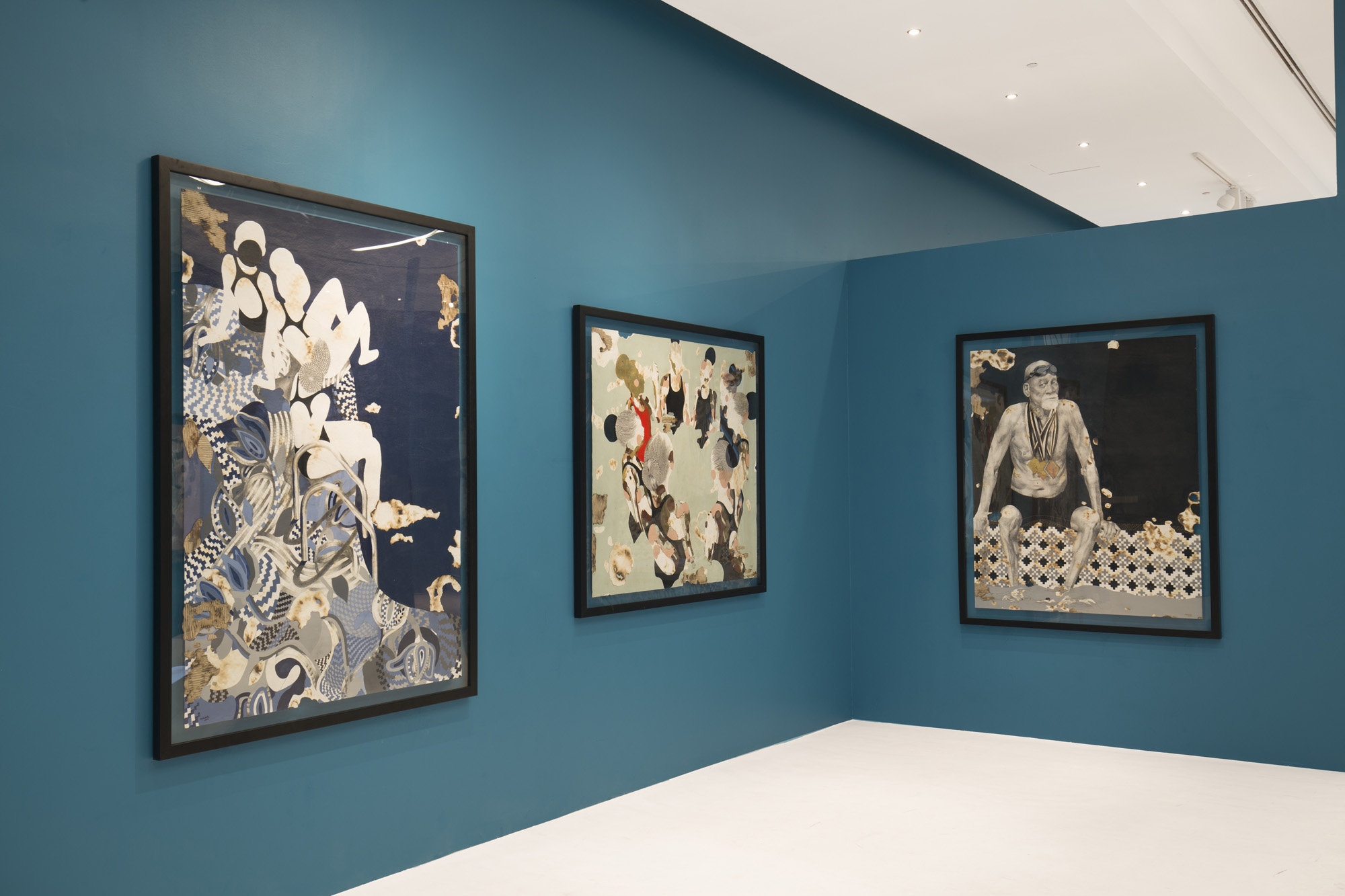The artist’s show at Gallery 1957, Dreams From The Deep End, transports us from the swimming pool to the art world in a celebration of togetherness
The Harlem Honeys and Bears are not shy of the limelight. Nigerian artist Modupeola Fadugba spent her summer residency at the International Studio & Curatorial Program (ISCP) in New York studying the city’s only all black synchronised swimming team for senior citizens, and she found that they lapped up the attention. Aged between 64 and 96 years old, most of them did not take to the water before retirement age but now find fame – and freedom – in the water. “They’ve been on morning TV shows and photographers have shot them. They love the camera and are ready to meet people,” Fadugba tells Nataal. “So at first when I’d ask questions, they’d give me the sound bites. But because we spent so much time together, I became an honorary member and was able to push past the sound bites to the real meat.”
This meat has become Dreams From The Deep End - her current solo show with Gallery 1957 in Accra. Entering the space, the multi media exhibition at first delivers a serene, playful and nostalgic experience. The walls have been painted joyful shades of aqua blue and your eyes are drawn to glimpses of The Harlem Honeys and Bears gracefully swimming past what look like porthole windows but are in fact video works. Listen closely and you’ll hear a soundscape of their friendly banter and choreographed strokes. But once you immerse yourself into the work, it soon demands you to consider questions around identity and social justice that have brought these men and women into view. There’s also a short film to watch documenting the artist’s time with the team, taking you from a BBQ in the backyard of a brownstone (“Thank the lord, bless the cook!” someone hollers over a tempting plate of chicken) to her eventual entry into the water to join the swimmers.
Most engrossing of all though are Fadugba’s new large-scale paintings, at once shining brightly with gold, silver and bronze leaf – her interpretation of the reflective luminance and movement of water - and damaged with burned marks, which add ominous textures to each piece. In amongst these rich layers are her painterly, monochrome muses looking confident, healthy and at ease. Inky blacks and hot reds compliment swirling splashes of pastels that bring these elderly athletes to life.
Fadugba, a keen swimmer herself, has often focussed on to the motif of black bodies in the swimming pool in such series as Tagged and Synchronized Swimmers. “I started painting swimmers competing with each other as a way to portray my own experience of having jumped into the deep end of the art world and attempting to navigate those unfamiliar waters,” she says. “My earlier works incorporate a red ball, which represents the red stickers placed on sold art works in commercial gallery settings, and how chasing these can make you drown. But now my swimmers are no longer competing, they’re collaborating in the depths. It’s about a sense of community and trust.”
“I’m interested in intergenerational dialogue and the life-saving lessons to be learnt inside and outside of the swimming pool”
Her research for the ISCP residency drew her to Jeff Wiltse’s book, ‘Contested Waters: A Social History of Swimming Pools in America’, which relates how communal pools have been sites of racial exclusion, tension and segregation. This gives context to Harlem’s own history as a place of black resistance, renaissance and excellence. The fact that some of her subjects hadn’t learnt to swim until their golden years speaks to their lack of access to and education in the water, and little has changed for successive generations with recent studies finding that black children in the US are five times more likely to drown than white children.
Fadugba’s painting, The Medallion Man, a likeness of the team coach Mr Luther, addresses these cultural hierarchies. “One day we went to the Empire State Senior Games where he won three medals. I took a photo of him wearing them all over a hoodie. An image of a black man in a hoodie holds symbolism of police brutality toward black men but he’s grown to a ripe old age and he’s triumphant,” she says. “He told me gives free weekly swimming lessons to kids, and works in a correctional facility where he teaches young, black men about building communities. I’m interested in that intergenerational dialogue and the life-saving lessons to be learnt inside and outside of the swimming pool.”
She ended up spending so much time with The Harlem Honeys and Bears that she felt that her usual abstract style of portraiture came up short in portraying their personalities. “When some of them visited my studio to see my previous work they were thrown off that the figures were not representative, which made me reconsider how I’d depict them. These are people who I have connected with, collectively and as individuals, so I am choosing to use a new, more true-to-life technique.”
Dreams From The Deep End is Fadugba’s most accomplished body of work to date. Born in Togo and spending some of her childhood in Rwanda, she studied chemical engineering, economics and education in the US before working in development in Nigeria. She made the decision to become a full time artist just four years ago thanks in part to her project, The People’s Algorithm - a human-scale, interactive game asking players to address Nigeria’s education and unemployment crisis - which received accolades at both the African Artists’ Foundation’s National Art Competition in 2014 and Dak’art in 2016. Since then she’s enjoyed solo shows in Paris, Lagos and London and has gained a growing reputation for her socially engaged practice.
“Modupeola’s show honours the ethos of The Harlem Honeys And Bears – their bodies, their power, their stories”
Having worked with London-based curator Katherine Finerty twice previously, Fadugba brought her on board for this show too, who helped her process the many questions raised by her research. One concern was why they were taking work that relates so directly to an African American audience in New York to a gallery in Accra. They turned to Yaa Gyasi’s acclaimed novel ‘Homegoing’ for answers. “It’s a beautiful book by a fellow young female creative who is interpreting the complicated history of her country and its international legacy,” says Finerty. “It starts in Ghana [in pre-colonial times] and ends up in [contemporary] Harlem, connecting all these dots of the transatlantic slave trade that brought its people to the south, who migrated north and who ultimately have become The Harlem Honeys and Bears… It’s an emotional mission for Modupeola to balance these greater socio political ideas with the personal lived experiences of these people and how it all relates to anyone who not only survives but thrives this space. This show honours the ethos of The Harlem Honeys And Bears – their bodies, their power, their stories.”
For Fadugba, the story does not end here. With the support of Gallery 1957, she plans to return to Harlem this autumn to present the works and documentary to Mr Luther and co and to continue to develop her ideas with them. She is also sharing some proceeds from sales with the team to help fund costumes and pool maintenance. “I want to go back and dive deeper,” the artist reflects. “There is so much to unpack and so much that hasn’t been said. This is a project that just keeps giving.”
Modupeola Fadugba’s Dreams From The Deep End is on view at Gallery 1957, Galleria Mall, Accra, until 31 October 2018
Nataal would like to thank the British Council’s West Africa Arts programme for supporting our editorial focus on Ghana







